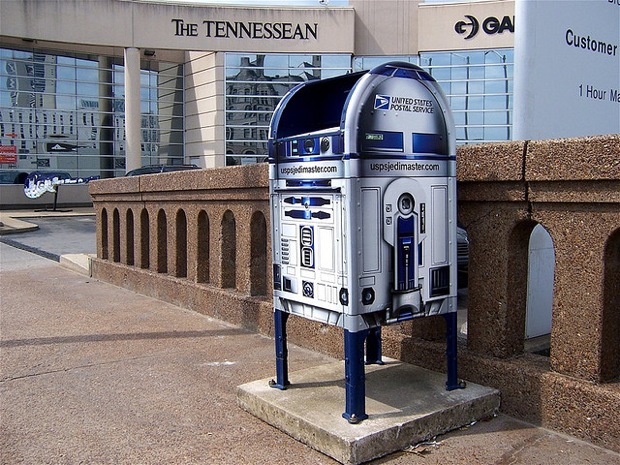
On Thursday, the U.S. Postal Service issued a daunting public statement about its current financial woes, and possible changes to its infrastructure and services that would aim to save the snail mail organization some $3 billion a year.
Under Postmaster General Patrick Donahoe's direction, the USPS is now specifically considering the closure or consolidation of 250 processing facilities, a reduction in mail processing equipment by as much as 50%, and a dramatic decrease of the Postal Service's nationwide transportation network. Overall, the postal service could see as many as 35,000 jobs, lost--according to the official government statement. Other estimates see job losses over 100,000 at the USPS.
The USPS blames its financial troubles, and "excess capacity" on the decline of snail mail. According to Thursday's press statement, "mail volume declined by more than 43 billion pieces in the past 5 years and is continuing to decline ... and letters bearing postage stamps declined 36% in the same time frame, and nearly 50% in the past ten years."
We've previously considered the benefits of a brand makeover, but could technology save the U.S. Postal Service?
The man who designed email as we know it--VA Shiva Ayyadurai--thinks yes, if only the post office would get back to its innovative roots. In email correspondence with Fast Company, Ayyadurai, who is also the founder of EchoMail, a serial tech entrepreneur, and teacher of cross-discipline engineering courses at M.I.T., noted:
"The first U.S. Postmaster General, Benjamin Franklin, was a superlative innovator. Like Henry Ford, he laid down a production system with the USPS for the receipt, sorting, routing and transport of mail while setting quality standards of training and delivery.
That was not a mere operational process of tweaking or refining an extant [business] to generate more revenue or reduce costs--but an inventive process.
Franklin created something new, a system that evolved to become the modern postal system. This evolution in media and communications cannot continue without ongoing, bold innovation."
Postmaster General Donahoe hails from a less entrepreneurial background than Benjamin Franklin. A 35-year veteran of the U.S. Postal Service, he managed the organization through decades when email began to cannibalize snail mail. In a bold, new world where email and information technology was rising, and snail mail would predictably decline, he never chose to lead the USPS away from the physical into the digital; he emphasized services like Priority Mail and First Class mail as revenue generators instead.
In the late '90s, the USPS was a $55 billion revenue business, the size of most Fortune 10 companies. VA Shiva Ayyadurai recalls:
"They were happy to be that, generating revenue from their consistent portfolio of products. But email was right there for them to own, if they wanted it. It was mail in electronic form being received, sorted, transmitted, and had to be done with reliability, speed and efficiency--all the core rubric of their entire model of transmitting mail.
Instead, the USPS saw themselves not as a communications organization but a paper mail delivery company, and this was and is the source of their downfall, and at least the source of lost opportunities."
Is it too late for the USPS to capitalize on email now? Regardless of whether the USPS stays public or is completely privatized, Ayyadurai believes it can save itself by creating and selling, not just using, digital communications technology. He says, "The U.S. Postal Service could offer an email management service to millions of businesses overnight, generating enough revenue to cover costs and make profit without layoffs. Global 2,000 companies and small to medium enterprises alike sorely need email management, which is a massive opportunity. They could also lead the charge in email validation and other solutions for a host of problems faced by email marketers."
Criticized as a "mail monopoly" by Cato Institute, the USPS could have a chance to re-train, rather than lay off 35,000 or more workers out of about 500,000 total employees. They would become engineers and customer service agents with some help. Ayyadurai estimates that enabling the workforce to create, sell, and deliver email management and marketing solutions could generate $6 billion for the USPS, though not necessarily in the same time frame Donahoe’s cuts would save it $3 billion.
Ironically, if the USPS stopped offering consistent, affordable snail mail delivery services all over the U.S., that could make a significant negative impact on the tech sector (until new, affordable shipping services evolved in the private sector anyway). E-commerce businesses from stalwarts like Amazon and eBay to Gilt Groupe and Birchbox rely, at least in some part, on the low costs and consistent availability of USPS shipping to keep their own services going, and margins healthy.
In other logistics news this week, UPS released a new mobile app called UPS MyChoice that lets "brown" package recipients choose a delivery time that works for them, and increases the likelihood of a successful first attempt delivery. The app also lets package recipients pay--if they so desire--a $5 fee to have UPS deliver their goods to another address (or a nearby UPS store) if it's more convenient. Mobile tech that's revenue generating, and makes consumers a little less frustrated. Donahoe, are you downloading this? It's all in the tech!
[Image: Flickr user Wonderdawg777]